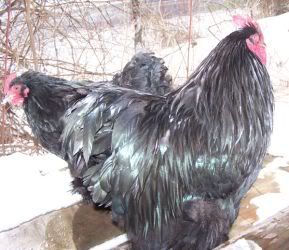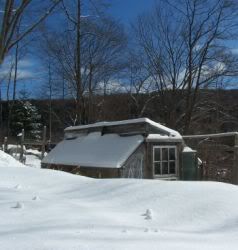A few questions came my way in the last couple of days, and I thought I would answer them all in one post. The first two are dealing with finished shawl from the previous entry. The third one deals with roosters.

Stacy from cledryyarner asked: Is that a yarnshifter you're using to make it?
My loom is not a yarn shifter, although I have heard of them and have seen them on a website.
I believe they (yarnshifters) are somewhat similar to the triloom or triangle loom, which is the loom design that I have used to make my shawls. I have several looms that we constructed by hand...but there are a few people who market the triangle looms. I learned how to make my loom a few years ago, when I had joined a yahoo group. There are a nice bunch of people in the group, and the photos of some of the shawls are very inspiring.
Terry of pygora blog asked: Do you full your yarn once it's spun, but before you weave or knit with it?
I normally just set the twist after spinning yarn, but sometimes I will experiment with different methods if I am trying to achieve a particular design. When I spin Angora, it usually goes through a process all its own to produce a nice "bloom". But in the case of this Border Leicester wool, that I had spun from the locks, I had simply set the twist with a soak in warm soapy water...and let dry (without weight or blocking). The thing that was so interesting, and something to make note of, was that in the fulling process of the shawl, the plied and set yarn returned to it curly lock texture.
I normally will full a shawl to a point where I like it. To do this, I fill a basin with warm soapy water, and immerse the finished shawl into it. I gently rub it around by hand, occasionally checking to see how much the weave is changing (getting tighter). When I have accomplished the look that I am going for, I will rinse and dry the shawl. With the BL shawl...the regular fulling was not happening fast enough for me, and I decided to shock the fiber a bit by dunking it into a basin of cold water. I think it was this shocking process that caused the yarn to result in the boucle' look. I should mention that when a fulled item is finished, you must always then wash it in the fashion that you normally would to prevent further shrinkage. If you were to continue with agitating and shocking the fibers, they would (sometimes depending on the fiber) continue to full...or even felt!
Now...moving on to the question about the roosters...
Gina of raisingfrolic asked: Do you keep the Roosters separated from the hens some of the time?? How much space do they all have to roam around in?

I keep my roosters with my hens all the time. I have 3 roosters and twelve hens. Two of the roosters are Aracuna, and one of them is a Black Cochin. The Black Cochin is named Buddy, and that (above) is a picture of him with his mate Honey. These are very gentle birds, and they stay together most all of the time. The other two roosters are years apart with the young one just becoming a cockerel...so they pretty much have established who is in charge and get along well with each other. As for the space they have to roam...they are pretty much free range. We only fence them in if we are going away, and the rest of the time, I let them out daily in the early morning, and they return to the coop by dusk, when we go out and lock the doors. When they come out to range, they tend to break off into little groups...with each rooster escorting several hens. They have worked out a definite pecking order about who "belongs" to whom....and I find it fascinating that the breeds seem to select "their own kind" to stay with.

The first days of March have dropped 6 inches of snow on us...I have dug a path to the greenhouse to get supplies for my starts. On your mark - get set- GROW! I started broccoli and lettuce because I only have 8 weeks before they need to be set out!



2 comments:
fascinating post!
Post a Comment